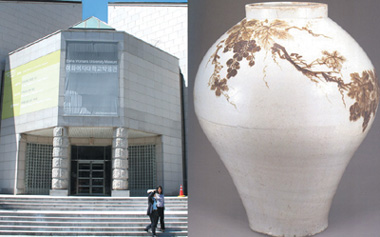
Commemorating its 70th anniversary, the Ewha Womans University Museum has been reborn, adding an extra floor underground to show the best of what it has saved. As the number "70" suggests, the Ewha museum has lived long and survived the dark periods of Korean history. Even during the Korean War, while Seoul was occupied by the North, the museum was re-established at the temporary Ewha campus in Pusan and remained in existence. Now owing to the new extension finished this year, the galleries are better than ever, and are divided into three parts: Permanent Exhibition, Donated Artifacts, and Temporary Exhibitions.
Entering the museum's front gate, you first walk through the permanent exhibition hall displaying Korean ceramics under the title, "A New Perspective on Korean Ceramics." A total of 280 accessions are on display and among many other items, the "Jar with Grapevine Design in Underglaze Iron," National Treasure No.107, is one of the most valuable treasures in the museum. The handsome shape of the jar, clear tone of the glaze, and the bold composition of the grapevines, reminiscent of literati paintings, make this jar the finest known white porcelain jar of the Joseon period.
Stepping down the stairs, you walk into the donated artifacts exhibition hall, which is newly opened this year thanks to the museum's enlargement. Now under the title of "Donated Artifacts Exhibition," a total of 300 artifacts donated by 180 people finally receive light this year. "The artifacts that should be looked on with particular interest in the donated artifacts exhibition hall are the Chinese ceramics and the large "Taegeuk Flag," says Kim So-yeon, a researcher at the Museum. "It is very difficult to find places where they display the Chinese ceramics in Korea. Now researchers can study the actual ceramics, and not just pictures," adds Kim. The Taegeuk Flag is also thought to hold great significance because it was the very flag that was used for the background in a photograph taken of the patriot Yun Bong-gil, before he made his bombing attack at Hongkou Park.
In the temporary exhibition hall, the next exhibition will cover the life of the late Professor Hwang Jong-gu of Ewha. The theme is planned to be "The Pioneer of Korean Ceramics: Scientist, Artist, Celadon Porcelain Maker Hwang Jong-gu."
The Ewha Museum has now become a must-go place to foreigners who visit Sinchon. But if there were no friendly docents around, the museum might not have given a big impression and be praised by the visitors like now. A researcher of the museum, Park Mi-yeon says, "The docent educating program is divided into two parts: educating themselves and educating others with what they have learned. Through this double education, the docent naturally becomes attached to the museum and spreads museum-loving stories around campus."
If you don't want to spend money but want to spend time meaningfully, you can drop by the museum and appreciate art for free. The museum is open every day from 9:30 a.m. to 5 p.m. except on Sundays and holidays, and you are always welcome to visit.

